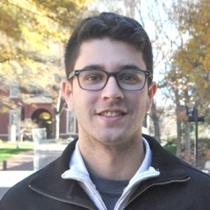
Phillip A Szot
What is your next adventure?
I'll be starting my graduate program with Dr. Lightsey, focusing, right now, on the RECONSO cubesat mission, where I've been a mission manager.
What about your next adventure are you most looking forward to?
I'm excited about getting to focus on system engineering, specifically in space systems. My career goal is to work in the area of human space flight, like the Dragon2, the Starliner, or the Orion vehicles. Systems-level engineering gives you the ability to do high-level integration of all aspects of mission operations. Systems engineers have to know how everything works together so they have to know about all of the components. If you can see how things mesh together at every level, you really have a good over-arching view of the mission.
In the last astronaut class, announced by NASA last year, there was a systems engineer from SpaceX, so I think that it's the right track for me.
Did you have any previous co-op, internship, or research experience in this area?
As a transfer student, I never managed to get around to setting up an internship or a co-op. I came to Tech in 2016, and I had to take all of my upper level AE classes, the ones I couldn't take anywhere else. That took up a lot of time. But I did get involved in research, with Dr. Holzinger and Dr. Lightsey.
I worked a lot in the Space Systems Design Lab (SSDL), where I've been training to be a satellite operator for the Armadillo cubesat, which was developed by Dr. Lightsey. We'll be doing the ground station for that here, on the top of Montgomery Knight so I wanted to be completely comfortable with the user interface. Armadillo been delivered to SpaceX for a launch with the STP-2 Mission, which is on the next Falcon Heavy. When it's up there, we'll be using that ground station to communicate with the satellite and to downlink telemetry and other data.
I've also been working on the RECONSO cubesat, flight mounting hardware for different boards, creating a mobile clean room, and assembling and testing the Heimholtz cage.
This past summer, I also got to work with Dr. Schrage as a part of NASA's Innovative Mars Exploration Education & Technology (IMEET) summer program, where I worked with high school students here and in Connecticut on simulating a mission to Mars, similar to what will be done in 2020 by the NASA Mars Program. I was instructing them in the basics of engineering - CAD, problem-solving, things like that.
How did your educational experience at Georgia Tech help you to achieve your goals?
It's just so amazing the chance that AE takes on undergraduates, the way they did 2 years ago when they let me join the RECONSO cubesat project. It started, really, when I was accepted as a transfer student and I visited campus. They gave us a tour of SSDL. It was really exciting to see the work, and I got to talk with grad students who were working on RECONSO and other cubesats. I started asking how I could get involved, and the grad students told me to go talk to Dr. Lightsey, who eventually invited me to campus for a mini-interview, to see what my strengths and experience were. That's how I got hooked into the RECONSO cubesat.
Another thing that helped me was doing a study-abroad semester in Limerick, Ireland. As a transfer student, I was coming into AE to take all of the higher-level classes with classmates who'd known each other for two years before I got here. But the friends I made in Ireland became my every-day support during the school year, and that made all the difference.
The faculty always challenge you at Tech, and they are always there to help you so you never feel lost. That's an important part of any student's success.
What advice would you give to an underclassman who would like to follow the same path?
If you area transfer student, do the 'trial and error of being a serious student' before you get to Tech, because when are in AE, it's serious business. And that's what I did at Berry College, where I started. I had my experience, there, of not studying enough for a test and seeing what that did. And I had support there, to help me see what I should be doing. So when I got to Tech, I'd thought a lot about what academics and a work-life balance meant to me. I was ready to take this challenge seriously, which you have to do, as a transfer student, because you don't have as much time.